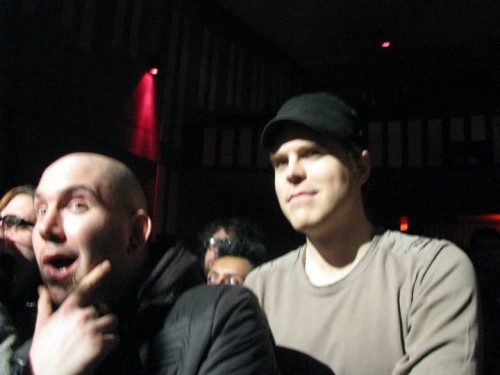Well, it’s been another rotation of this here third planet around that big old sun and somehow, through deadlines, heatwaves, and software crashes, we’re still plugging away at I Die: You Die. Things have changed a wee bit since the last time we did an anniversary post, and so we thought we’d once again check in on the state of the industrial union. As always, we want to hear from you folk: what’s been happening in your part of the ‘plex for the last year? Where do you see Our Thing headed? Will Al ever actually pull the plug on Ministry?
The trend of weekly club nights dying off can’t really be thought of as a “trend” anymore and should probably be viewed as a semi-permanent shift for the time being. As we’ve talked about on the podcast, people are less and less likely to lock themselves into a particular subculture or style when there’s the entire history of human cultural output from which to sample and oh so many choices as to where to go dancing on a Friday night. This isn’t a phenomenon unique to the industrial/goth nexus, but it’s certainly one that needs to be taken seriously by its promoters, with new strategies for building events, recognition of music, or whatever the hell a “scene” amounts to in 2015.
Thankfully, one Newtonian reaction to this shift rests in the gradual but steady effacement of barriers between bands or people considered “true” or “real” industrial fans or bands and those who might have a slightly different subcultural pedigree (or just a more sensible haircut) than others at a club night or festival. A wise man once said “it ain’t where you’re from, it’s where you’re at“, and that finally seems to be sinking in as people notice that scenes like ours aren’t walled off from others but share open and negotiable borders. In 2013 we wrote a piece decrying arbitrary sectarianism in Our Thing. Two years later, it reads like a pleasantly unnecessary corrective to a problem which simply no longer exists. People of all ages are, on the whole, more willing than ever to give new spins on old styles a chance (minor health goth harrumphs aside), and the younger bands which are finding new hybrids and re-presentations are being given the credit they deserve.
That said, it’s not only young bands people are excited about right now, and we can’t help but notice how much the broader perception of genre mainstay bands has shifted since we started the site. Where Gristle, Coil, Test Dept, and Neubauten have long been name-check bands for folks who want to curry a little cred, the surge in genuine interest in artists from Our Thing’s mass history has been fascinating to watch. Part of it almost certainly has to do with folks who came of age in the 90s hitting their midlife point (crisis optional) and revisiting their Puppy and Ministry records, but we’ve also seen a lot of young fans connecting the dots from their initial exposure to NIN onwards in record time. That’s not to mention how a service as ubiquitous as Spotify or Youtube can basically usher a fan of any age through songs and albums that they wouldn’t have had such easy access too a few years back. More and more the barrier to fandom has to do with desire more than access, and we’re just romantic enough to feel heartened by that.
Of course the decline of the record industry has been well underway for more than a decade when we posted our first article, and a lot of folks would likely argue that things are more dire for recording artists today than they have been at any point in the history of recorded music. It’s a neverending debate with a near endless amount of arguments for either side, none of which have much of an effect on the reality of the situation; things done changed and continue to do so at an alarming rate. The current debates over issues like streaming revenues and crowdfunding weren’t on the map in 2011 but have put the relationship of the artist and their fans in sharp relief; whether it’s via patronage or some other yet to be determined model, the way we consume music and remunerate the folks who make it is more dependent than ever on cultivating a real back and forth between listener and musician. Reproduction and distribution have held economic sway over art since the dawn of time, and with the rules being redrawn this quickly the real capital these days seems to be in fan investment more than anything else.
When we started I Die: You Die neither of us had any idea how long we would end up writing for the site, or whether anyone would care what we had to say. It’s not an understatement to say that if folks hadn’t encouraged us with their feedback and by sharing our work with their friends, we wouldn’t still be putting the time in. Not only that, we’ve been blessed with some particularly wonderful opportunities to interact with artists we’ve admired for years, specifically because our readers lent us credibility via their enthusiasm for our work on ID:UD. That’s more than we ever could have hoped for, and we can’t possibly thank you enough for everything you’ve done for us.
So with that, we embark upon our fifth year emboldened, encouraged, and hell, maybe even a little wiser. Whether on the site or on the podcast, we can’t wait to keep the conversation going with you guys. It’s I Die: You Die, baby. Can’t stop. Won’t stop.







Great commentary and a solid recap of the state of the scene. I just went to a new club night that was hosted by a gay DJ who typically spins at gay events, but it was billed as a dark night of dance and cross-promoted to the local goths. The crowd was a sublime mix of goths and gays. I found it delightful watching gays dance to Nitzer Ebb and VNV and goths dance to Yaz and The Presets. More of that please.
I’ll pull the card of any goth who won’t dance to Yaz.
Nice summary! I agree about the way the landscape of music distribution has changed such that the back-and-forth between listeners and musicians has come to the forefront.
“…a service as ubiquitous as Spotify or Youtube can basically usher a fan of any age through songs and albums that they wouldn’t have had such easy access to a few years back. More and more the barrier to fandom has to do with desire more than access, and we’re just romantic enough to feel heartened by that.”
I’m with you on that for sure. Recently I met a couple of new dark ambient fans who were more than 20 years my junior. They were talking about how impressed they were with stalwarts in the dark ambient scene like Ulf Söderberg, Herbst9, and Desiderii Marginis, and how they discovered all this music via YouTube. It made my day, and reaffirmed my commitment to keeping up with my own writing about dark ambient music.
Nice! I know that ease of distribution can often run against the hermetic and reclusive feel many dark ambient artists shoot for…but certainly the Internet can afford some agency in terms of degree of engagement.
One of the topics you mentioned was the surge in interest in the history of Y/Our Thing. For a long time, it felt like “The History of Industrial” was a fixed period from around 1975-1995 (origin to peak mainstream visibility), and anything past that was simply considered contemporary: even in the book Assimilate, the discussion of the turn-of-the-millennium era comes off as rushed (decent discussion of Futurepop, very little detail on Aggrotech or Powernoise), and the post-2000 developments aren’t really covered at all. But 2000 was as long ago now as 1985 was in 2000! Do you think the current surge of interest in history will extend to bands from the early-mid 2000s?
We were having a discussion along these lines just a week ago. Stay tuned…maybe?
When I was first getting into this stuff, way back in the mid-nineties, I somehow got the impression that the industrial scene would be populated by exceptionally smart open-minded individualistic folks. In my naïve and no doubt self-flattering imaginings, there would be none of the fashion victims, lunkheads, and elitist scenesters I encountered at school, flaunting their Metallica t-shirts and blasting gangsta rap from their parents’ minivans. But most of all, the music seemed like a blank canvas and an endless palette. You could just take drips and drops of whatever you had in your head, and set it to any kind of music you liked. A certain darkness and grittiness was expected – this was music of alienation, after all – but you could make it as synthy and technoid, or as chugga chugga metallic, or as doomy and gothy, or as punked up aggro, or as skreeky skronky experimental as you liked, and it would somehow just make sense.
Then I actually started meeting people in the scene. Can you say “disillusion”? Turns out, the “scene” was just as plagued with assholes and doofuses, Queen Bees and Mr. Know-It-Alls as any other. Worse than that, though, were the endless discussions: “That’s not industrial! They use guitars!”, “Oh, that’s not EBM, that’s nothing but gothic disco”, “Did I just hear a real drum?”, “Trent Reznor ruined industrial music”, and on and on. What was WRONG with these people? Were they not seeing the possibilities I was seeing? We were all free to construct a version of industrial music that appealed to us, weren’t we? Why were they trying to put this music in a teeny-tiny box?
Well, since then, there have been ebbs and flows, good years and bad years, the rise and fall of micro-genres and sub-scenes, and endless evolution through it all. And now, there are folks coming at what I call “industrial music” from all different directions… and it all somehow just makes sense! As you say, “scenes like ours aren’t walled off from others but share open and negotiable borders”. It’s truly Our Thing – Your Thing, My Thing, Anybody’s Thing who wants a piece of it. And there seems to be a tacit acknowledgement that all of our Things may not precisely coincide, but they overlap enough that we can talk about them without getting bogged down in petty hair-splitting. Why, we were free to construct a version of industrial music that appeals to us all along! There have been exciting times in this genre before, but this is the first time that I can look around at what’s going on today, and find an industrial scene that resembles my idealistic teenaged misconceptions.
And I have to say, it’s pretty nice.